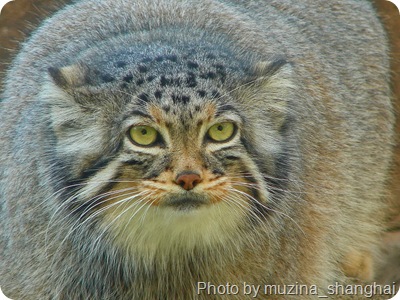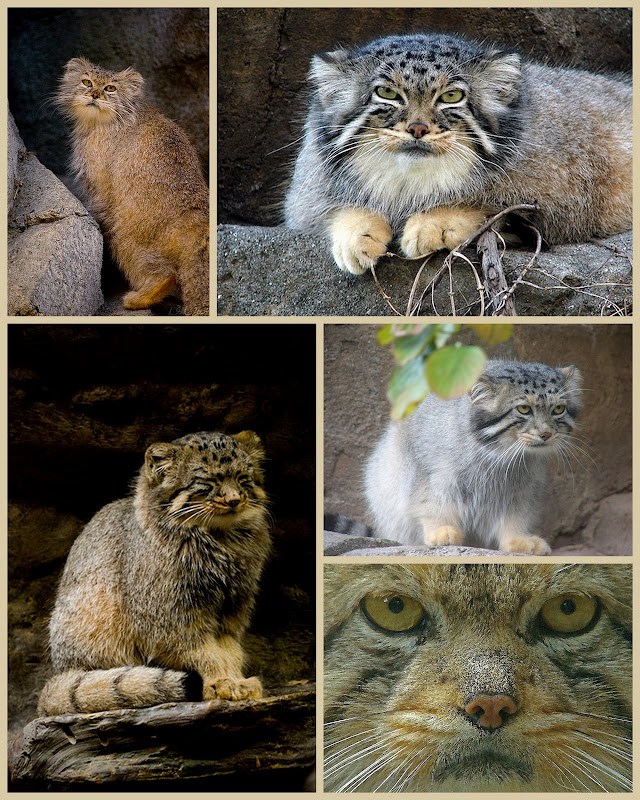
Pallas cat or more accurately, Pallas’s cat. Photo by muzina_shanghai
The internet stops me from using this cat’s true name in the headline: Pallas’s Cat as apostrophes don’t work in file names and the file name should be the same as the headline. Sorry for that. The other English name for this cat is Manul. The latin or scientific name is Otocolobus manul. I will generally call this cat pallas cat in this article. The scientists prefer manul. A translation of the Russian and German name for this cat is: Steppe cat.You can see how complicated it gets even at the level of the name!
Its name comes from its discoverer, a German zoologist and botanist, who worked in Russia after being invited in 1767 to become a professor at the St Petersburg Academy of Sciences by Catherine II who seems to have been a great admirer. He completed two expeditions into deepest Russia, reaching as far eastward as Lake Baikal (see photo below – part of the range of this cat) on the first expedition (between 1768 and 1774) and discovered Pallas’s cat. He wrote about his findings in a 3 volume book called: Journey through various provinces of the Russian Empire.
The pallas cat is, I think it fair to say, very distinctive. It’s appearance (and I mean head/body conformation or shape) is different; much in the same way the shape of the Jaguarundi (weasel looking) is different. This difference comes from the roundness and shortness of the head (the skull more accurately). In fact its skull is similar to that of the sand cat. This is considered by some to represent an advanced state of development of the “domestic cat lineage”. It is thought to have split from the domestic cat lineage early on (the pallas cat is the only cat in the domestic cat lineage to not carry a specific gene common to other ancestors of the modern domestic cat).
So what does this distinctive cat look like? The pallas cat is similar in size to our well known domestic cat, weighing between 2 – 4 kilogrammes (4.4 lbs – to 8.8 pounds). In fact, it is probably a little lighter than the domestic average at around 8 lbs. As stated its head is round with a low or flat forehead and its legs a little short. The fur is long and the tail very bushy.

Pallas cat collage – photos from top left going clockwise are by: nsjmetzger, muzina_sha
Looking at these pictures taken in captivity, this cat seems friendly and inquisitive (looking at the camera) and mild mannered, which is in fact the case. Apparently in captivity they show no fear. However, in captivity they fail to thrive as offspring frequently die at a young age. This is thought mainly to be due to the parasite toxoplasma gondii. The reasons were being researched.
Another very noticeable feature is the small ears filled with hair (called “ear furnishings” in the cat fancy) and which are set well on the side of the head. The ears are adapted to the terrain in which this cat has to stalk prey. It is open ground with sparse vegetation and serval like ears would be too visible. These are a bit like the ears of the purebred, domestic Persian cat. The cat fancy (following expert scientists) at one time thought that the pallas cat was the wild cat origin of the original Persian cat and this may be the reason why they bred the ears small and on the side – not sure. This is the CFA breed standard:
EARS: small, round tipped, tilted forward, and not unduly open at the base. Set far apart, and low on the head, fitting into (without distorting) the rounded contour of the head.
The facial markings are actually very strong but vary in intensity. There are distinct white bands bounded by black running from the corner of the eyes going back and down slightly. And on the forehead there are black spots. The tail has black bands and a black tip. The coat is quite plain and heavily “ticked”, which is a cat fancy term meaning broken coloration by the agouti gene. It is designed, of course, to blend in, which it does very successfully. The coat nicely matches the rocky outcrops of the uplands and hilly areas that it occupies. See another Pallas cat picture.

Say “NO” to animal breeders
Hi Anette. Thanks for stopping by and commenting. Running a website about cats, I have to mention the cat breeds which leads to getting to know some breeders, who become friends, so I do have a problem criticising cat breeding. However, at heart, I am in harmony with you on this because there are too many unwanted cats.
I agree. I took in a mother Bengal and her two daughters in because the breeder couldn’t sell them after a year of asking me to take one. My kind-hearted mom said, “Oh bring all three of them.” Now, I don’t even have a job anymore. However, I’m glad they are here, because I don’t think they could be separated. They cling to each other like monkeys. They are always bunched up together. Very cute. Sometimes, the 3 of them pile up on top of me while I’m sleeping and I can’t move. Luckily, my sister’s friend decided to quit breeding Bengals. Thank God. There are enough pets getting abandoned all over the place. I think cat and dog breeding should be outlawed because it has gotten way out of control. Someone dumped a pregnant female in my neighborhood (and who did she make a beeline for? Me!) about 6 months after I took in the Bengals. She gave birth within 2 weeks after I took her in after realizing she was pregnant. She gave birth to 5 babies. So, we ended up taking in 9 cats within a 1 year period!!! I couldn’t find homes for them either and they live here wreaking havoc. They are super cute, though. So people should find some other ways to make money. People should also choose going to a shelter over a breeder as well. If purebreds are what they want – there are a bunch at the shelters. Poodles, German Shepherds, Chihuahuas, Maltese, Bichon, etc. for people looking for dogs. There are Persians, Abyssinians, Siamese, Bengals, etc. for people looking for cats.
Great comment. Enjoyed reading it. I totally agree with you. There is a pet shop near me where they sell kittens. I like the people and the products but hate the fact they sell animals. Horrible. They just don’t think about the consequences.
You have done really well taking on these cats but…too much really. It is the same old story, people like you and me mop up the mess that others create. The irresponsible lean on the responsible. It was ever thus.
People who care about animals can’t say no to saving an animal.
where do you buy a pallas cat ?
You can’t buy one for a pet. They are a true wild cat and rare. You couldn’t keep one in a private zoo without having proper facilities and complying with any regulations. I am not sure what the regulations are where you live but in some states in the USA it would be illegal to keep a Pallas’s cat. They are protected and export from Asia is banned I would have thought. Someone in the USA probably keeps one but they are very rare. Sorry but hope this helps.
I like looking at pictures of these wildcats. it makes me sick that people are breeding and selling these as exotic-domestics. I hope they start to do more to protect these beauties in the wild. it would be a shame to see them become extinct.
Absolutely. I have always said that we should be spending far more time and effort on protected wild cats in the wild rather than trying to breed them in cages. It seems mad to me and very self indulgent and human-centric.
Did you even read the article?? Wtf!!